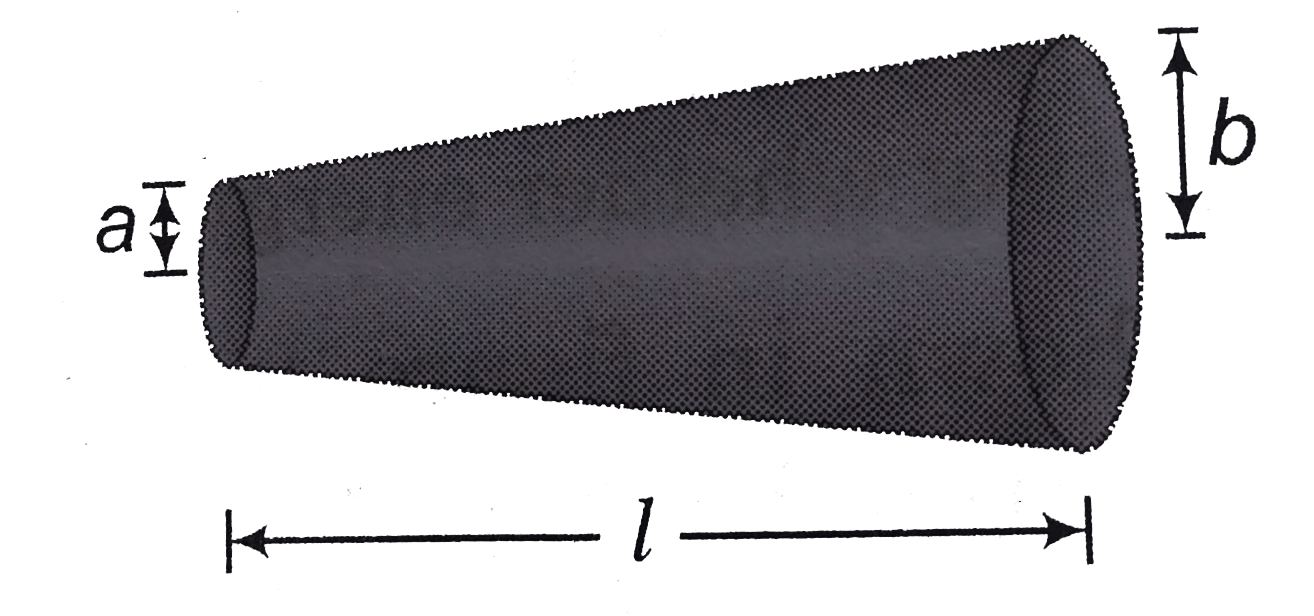A conductor of uniform area of cross section A has a variable resistivity along its length. What will be the resistance of the conductor if ρ=ρ0(1+αx2), at length l.
To find the resistance of a conductor with a variable resistivity given by ρ=ρ0(1+αx2) over its length L, we can follow these steps:
1. Understand the Problem: We have a conductor of length L and uniform cross-sectional area A. The resistivity ρ varies along its length according to the formula ρ=ρ0(1+αx2).
2. Consider a Differential Element: Take a small element of the conductor of length dx at a distance x from one end. The resistance dR of this small element can be expressed using the formula:
dR=ρdxA
3. Substitute the Variable Resistivity: Substitute the expression for ρ into the equation for dR:
dR=ρ0(1+αx2)dxA
4. Integrate to Find Total Resistance: To find the total resistance R of the conductor, integrate dR from 0 to L:
R=∫L0dR=∫L0ρ0(1+αx2)Adx
5. Separate the Integral: This integral can be separated into two parts:
R=ρ0A(∫L01dx+α∫L0x2dx)
6. Evaluate the Integrals:
- The first integral:
∫L01dx=L
- The second integral:
∫L0x2dx=(x33)L0=L33
7. Combine the Results: Substitute the results of the integrals back into the equation for R:
R=ρ0A(L+αL33)
8. Final Expression for Resistance: Thus, the total resistance R of the conductor is given by:
R=ρ0A(L+αL33)
Final Answer:
R=ρ0A(L+αL33)
dR=ρdxA
dR=ρ0(1+αx2)dxA
R=∫L0dR=∫L0ρ0(1+αx2)Adx
R=ρ0A(∫L01dx+α∫L0x2dx)
- The first integral:
∫L01dx=L
- The second integral:
∫L0x2dx=(x33)L0=L33
R=ρ0A(L+αL33)
R=ρ0A(L+αL33)
R=ρ0A(L+αL33)
Topper's Solved these Questions
- BOOK - MODERN PUBLICATIONCHAPTER - CURRENT ELECTRICITYEXERCISE - CONCEPTUAL QUESTIONS35videos
CURRENT ELECTRICITY
- BOOK - MODERN PUBLICATIONCHAPTER - CURRENT ELECTRICITYEXERCISE - TOUGH AND TRICKY PROBLEMS23videos
CURRENT ELECTRICITY
- BOOK - MODERN PUBLICATIONCHAPTER - CURRENT ELECTRICITYEXERCISE - Chapter Practice Test15videos
CURRENT ELECTRICITY
- BOOK - MODERN PUBLICATIONCHAPTER - ATOMS EXERCISE - Chapter Practice Test16videos
ATOMS
- BOOK - MODERN PUBLICATIONCHAPTER - DUAL NATURE OF RADIATION AND MATTER EXERCISE - CHAPTER PRACTICE TEST15videos
DUAL NATURE OF RADIATION AND MATTER
Similar Questions
A wire of resistivity ρ is stretched to twice its length. What will be its new resistivity ?
View SolutionA wire of given metarial having length l and ares of cross-section A has a resistance of 4Ω. What would be the resistance of another wire of the same meterial having length l/2 and area of cross-section 2A ?
View Solution
Knowledge Check
- Question 1 - Select One
A conductor of length l and area of cross-section A has a resistance R then its specific resistance is
Aρ=RAlBρ=RAlCρ=lRADρ=R2Al - Question 2 - Select One
A cylindrical conductor of length l and uniform area of cross section A has resistance R. Another conductor of length 2l and resistance R of the same material has an area of cross section
AA2B3A2C2AD3A - Question 3 - Select One
A cylindrical conductor of length l and uniform area of cross section A has resistance R. Another conductor of length 2.5l and resistance 0.5R of the same material has an area of cross section
A5AB2.5AC0.5AD15A
A conductor of length l has a non-uniform cross-section. The radius of cross-section varies linearly from a to b. The resistivity of the material is ρ. Find the resistance of the conductc across its ends.
 View Solution
View SolutionA cylindrical conductor of length l and uniform area of cross-section A has resistance R. Another conductor of length 2l and resistance R of the same material has area of cross-section :
View SolutionA cylindrical conductor of length .l. and uniform area of cross section .A. has resistance .R.. The area of cross section of another conductor of same material and same resistance but of length .2l. is
View SolutionA cylindrical conductor of length 'I' and uniform area of cross-section 'A' has resistance 'R'.
Another conductor of length 2.5 I and resistance 0.5 R of the same material has area of crosssectionView SolutionA cylindrical conductor of length l and uniform area of cross-section A has resistance R. Another conductor of length 2l and resistance R of the same material has area of cross-section :
View Solution

